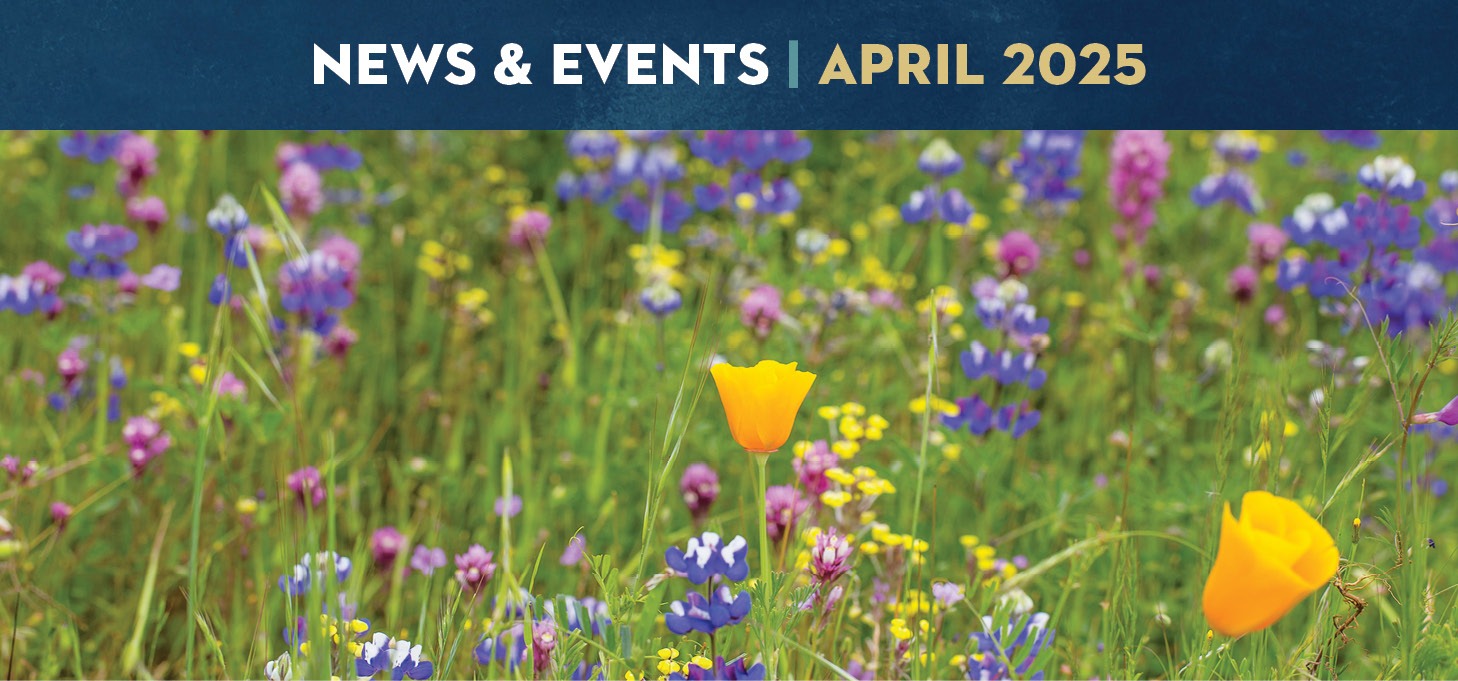
Spring has arrived, and Sonoma County’s hills are bursting with color! Now is the perfect time to get outside and explore. In this edition, we’re sharing the best places to see wildflowers, guides to help you identify them, and resources to make your spring outings fun and easy for the whole family. Grab your hiking boots and a field guide—wildflower season has returned!
Sonoma in bloom: a springtime wildflower guide
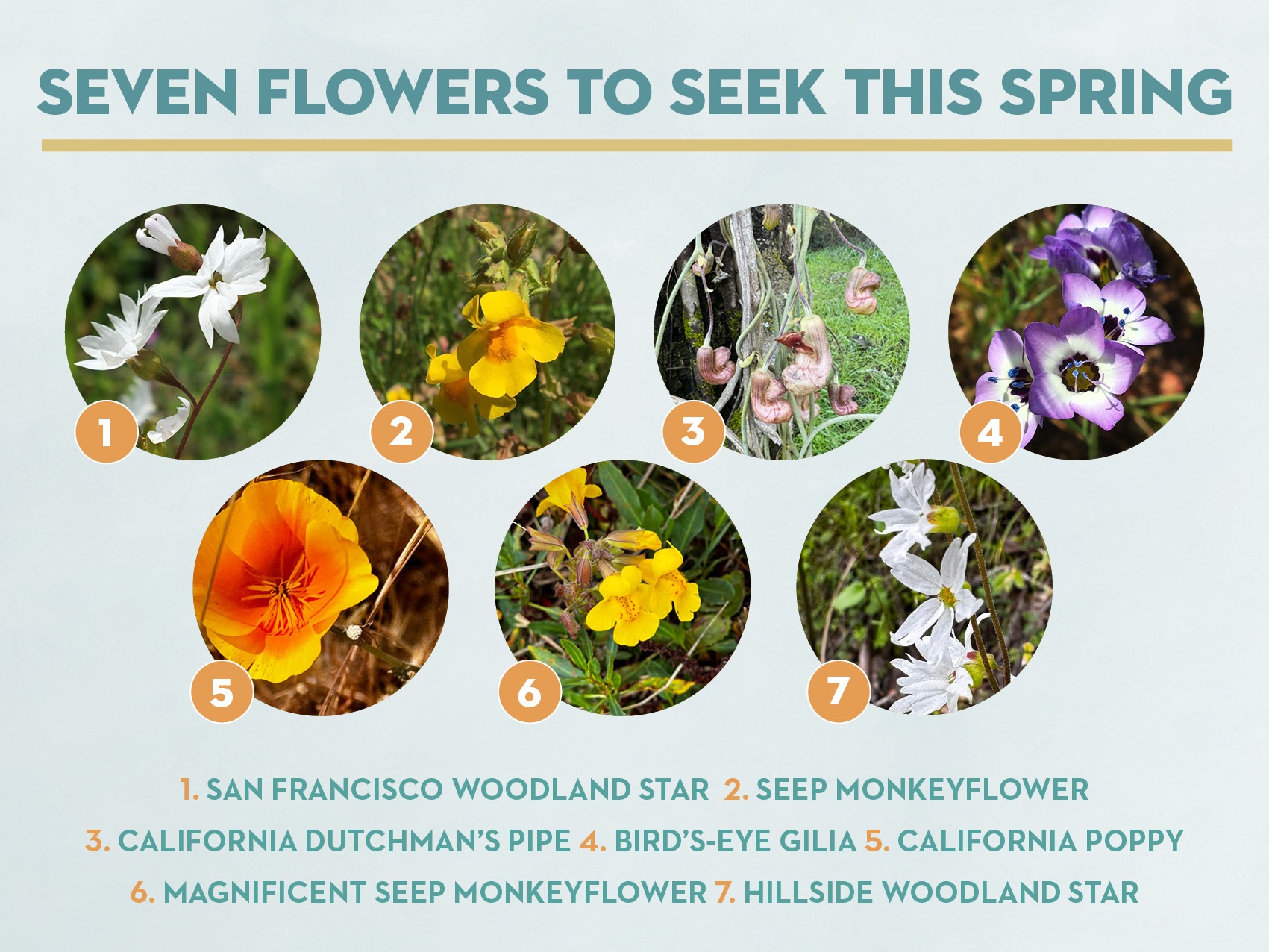
Wildflowers are among the most telling signs that spring has arrived. Across Sonoma, Napa and Mendocino counties, we have over 350 wildflower species to discover. Here are some of our favorite wildflowers and where you can find them this spring.
As the state flower of California, the flashy California poppy (Eschscholzia californica) can be found blooming along roadsides, in ditches, and across open grasslands. There is also a related variety right here in Sonoma County! The Tufted Poppy (Eschscholzia caespitosa) lacks the pink disc beneath its brilliant orange petals and prefers chaparral habitats. We recommend the Horseshoe Cove Overlook Trail at Bodega Head for observing these cheerful blooms. They thrive in disturbed soil, so you may also find them in unexpected spots along the road.
In Sonoma County, we’re lucky to have two species of the woodland star–the Hillside woodland star (Lithophragma heterophyllum) and the San Francisco woodland star (Lithophragma affine). Sometimes, they can be found just feet apart on the same trail! You can tell them apart by the shape of the ovum (under the flower): Hillside woodland stars have square-shaped ovum while the San Francisco woodland star has pointy-shaped ovum. The Sonoma Valley Trail at Sonoma Valley Regional Park is a family-friendly, paved pathway where you’re likely to see this dainty flower. Pay special attention to areas where the stream approaches the trail, as you might also encounter monkeyflowers, buttercups, sun cups, and larkspur. The Creekside Trail in Shiloh Ranch Regional Park is also an excellent spot to search for both species of woodland star.
Bird’s-eye gilia (Gilia tricolor) blooms from March through May and is prominent on the slopes of Lawson Trail in Hood Mountain Regional Park. This white and purplish flower prefers open, wet areas rather than dry meadows. They often have a sweet scent similar to chocolate, or some say a musky scent known to thrive in areas recently affected by fire, as its seeds often require smoke or heat for germination.
Look for Seep monkeyflower (Erythranthe guttata) and Magnificent seep monkeyflower (Erythanthe grandis) from now until May. Wet, north-facing roads and trail embankments may feature these shade-loving blooms. Consider exploring the beach cliffs around Bodega Bay and the Sonoma Coast, as well as the inland trails at Hood Mountain Regional Park, Trione-Annadel State Park, North Sonoma Mountain Regional Park, and Sonoma Valley Regional Park. The main difference between these species is size: the Magnificent seep monkeyflower grows along the coast in Sonoma and when it comes to size, it has double the flowers and foliage!
California Dutchman’s pipe (Aristolochia californica) has a bulbous shape and purple-striped flowers that you can see right now. Be aware that the flowers emit a mildly unpleasant odor, which helps attract certain pollinators, specifically carrion-feeding insects. Pipevine swallowtails (Battus philenor) lay their eggs on the underside of this plant’s leaves. Once they hatch, the caterpillars feed on those leaves until they metamorphose. For a unique pocket park experience, visit Ag + Open Space’s Paulin Creek Preserve and look for this woody vine. You may also have luck finding this bloom at Sugarloaf Ridge State Park and Trione-Annadel State Park.
You can see wildflowers in many places this spring. Get your wildflower guide if you haven’t already, and you’ll be all set to hike and explore some of our favorite wildflower spots in Sonoma County. For a guided adventure, register today for our upcoming wildflower hikes at sonomalandtrust.org/outings
Sonoma en flor: una guía de flores silvestres en primavera
Las flores silvestres son uno de los signos más evidentes de que ha llegado la primavera. En los condados de Sonoma, Napa y Mendocino tenemos más de 350 especies de flores silvestres por descubrir. Estas son algunas de nuestras flores silvestres favoritas y dónde puedes encontrarlas esta primavera.
Como flor del estado de California, la llamativa amapola de California (Eschscholzia californica) puede encontrarse floreciendo en los bordes de las carreteras, acequias y praderas abiertas. También hay una variedad afín aquí mismo en el condado de Sonoma. La amapola Eschscholzia caespitosa, o como se conoce en inglés Tufted Poppy, carece del disco rosa bajo sus brillantes pétalos naranjas y prefiere los hábitats de chaparral. Recomendamos el sendero Horseshoe Cove Overlook en Bodega Head para observar estas alegres floraciones. Prosperan en suelos alterados, por lo que también puedes encontrarlas en lugares inesperados por la carretera.
En el condado de Sonoma, tenemos la suerte de contar con dos especies de Lithophragma, o como se conoce en inglés Woodland Star: la Lithophragma heterophyllum (Hillside woodland star, en inglés) y la Lithophragma affine (San Francisco woodland star, en inglés). A veces pueden encontrarse a solo unos pies de distancia en el mismo sendero. El sendero Sonoma Valley, en el Parque Regional del Valle de Sonoma, es un camino pavimentado apto para familias donde es probable que veas esta delicada flor. Presta especial atención a las zonas donde el arroyo se acerca al sendero, ya que también puedes encontrar flores del mono, botones de oro, Camissonia californica (conocida en inglés como California Suncup) y espuelas de alondra. El sendero Creekside del Parque Regional del Rancho Shiloh también es un lugar excelente para buscar ambas especies de Lithophragma.
La ojo de pájaro (Gilia tricolor) florece de marzo a mayo y destaca en las laderas del sendero Lawson en el Parque Regional de Hood Mountain. Esta flor blanca y violácea prefiere las zonas abiertas y húmedas a los prados secos. Suelen tener un aroma dulce parecido al chocolate, o algunos dicen que un aroma almizclado conocido por prosperar en zonas afectadas recientemente por incendios, ya que sus semillas suelen necesitar humo o calor para germinar.
Busca la flor del mono (Erythanthe gluttata) y la Erythanthe grandis, o como se le conoce comunmente en inglés la Magnificent seep monkeyflower, desde ahora hasta mayo. Los caminos húmedos orientados al norte y los terraplenes de los senderos pueden presentar estas flores amantes de la sombra. Considera la posibilidad de explorar los acantilados de la playa alrededor de la bahía de Bodega y la costa de Sonoma, así como los senderos del interior en el Parque Regional de Hood Mountain, el Parque Estatal de Trione-Annadel, el Parque Regional de North Sonoma Mountain y el Parque Regional de Sonoma Valley. Su tamaño es la diferencia clave entre estas especies: la Erythanthe grandis crece a lo largo de la costa de Sonoma y tiene el doble de flores y follaje.
La pipa del holandés de California (Aristolochia californica) tiene forma bulbosa y flores con rayas moradas que puedes ver ahora mismo. Ten en cuenta que las flores emiten un olor ligeramente desagradable, que ayuda a atraer a ciertos polinizadores, concretamente insectos carroñeros. La cola de golondrina azul (Battus philenor) pone sus huevos en el envés de las hojas de esta planta. Una vez que eclosionan, las orugas se alimentan de esas hojas hasta que completan su metamorfosis. Para vivir una experiencia única en un pequeño parque urbano, visita la reserva Paulin Creek de Ag + Open Space y busca esta enredadera leñosa. También puedes encontrar esta flor en el Parque Estatal de Sugarloaf Ridge y en el Parque Estatal de Trione-Annadel.
Esta primavera podrás ver flores silvestres en muchos lugares. Si aún no tienes tu guía de flores silvestres, consíguela y prepárate para hacer senderismo y explorar algunos de nuestros lugares favoritos de flores silvestres en el condado de Sonoma. Para una excursión guiada, inscríbete hoy en nuestras próximas caminatas de observación de flores silvestres en sonomalandtrust.org/outings. gado la primavera, transformando las colinas del condado de Sonoma en un vibrante tapiz de color y textura.
Fire and flora: how wildfires reveal plant evolution

In the rugged landscapes of Sonoma County, the Nuns Fire of 2017 and the Kincade Fire of 2019 left their indelible mark on the land. Yet, beneath the charred earth and blackened forests, a powerful ecological story emerged—one of resilience and renewal. These wildfires have provided compelling evidence that plants in Northern California have evolved alongside fire, thriving and returning in its aftermath, with some reawakening after decades of dormancy.
Evolution Through Fire
For millions of years, plants have adapted to survive and even flourish in fire-prone environments. Many species in Northern California possess fire-adapted traits, such as underground bulbs and rhizomes, that allow them to regenerate after a blaze. However, some species go beyond mere survival; they depend on fire to reproduce. These “fire followers” have evolved strategies to take advantage of the nutrient-rich, open landscapes that wildfires leave behind.
Sonoma Land Trust’s Living Laboratory
At Sonoma Land Trust’s Glen Oaks Ranch and Secret Pasture Preserves, the impact of fire on botanical communities has been profound. One remarkable example is the Bush poppy (Dendromecon rigida), which thrives on open ground after a fire. With a short lifespan of six to ten years, this plant often disappears as other species outcompete it. However, its seeds lie dormant in the soil, awaiting the next blaze to complete their life cycle. Today, these golden blooms can be found on the ridge above Merganser Pond at Hood Mountain Regional Park
A Surge in Species Abundance
In the wake of the wildfires in 2017 and 2019, pre-eminent botanist Peter Warner conducted surveys on four Sonoma Land Trust properties, including Glen Oaks and Secret Pasture. Warner found 30% more plant species during post-fire surveys than he did during the same type of survey in 2015. Notably, this included surges in the abundance of certain rare species. Species that had been dormant for decades reappeared, revealing the hidden vitality that fire can unlock.
This phenomenon was echoed in the Fire Followers Campaign, a community science initiative led by the California Native Plant Society (CNPS). Through iNaturalist, tens of thousands of community scientists documented botanical finds in 2020 and 2021, further confirming the resurgence of fire-adapted species.
A Case for Prescribed Fire
While the resurgence of plants like the Bush poppy is a hopeful reminder of nature’s resilience, ecosystems and their diversity can suffer when humans alter natural fire regimes. In southern California, fire-adapted chaparral communities have been in decline because the fires have been too frequent, too intense, and too large. In our area, oak forests suffer from too little fire, which leads to a buildup of fuels and competing vegetation. Many communities have faced devastating losses from catastrophic wildfires too, as the recent 2025 Eaton Fire and Pacific Palisades reminded us. The challenge ahead lies in finding a way to foster a more “pyro-diverse” landscape—one that supports a mosaic of vegetation ages and conditions, reduces fuel loads, and protects both ecosystems and human communities.
The wildfires that tore through Sonoma County years ago revealed a deeper ecological truth: plants here have evolved with fire and thrive in its aftermath. From the resilient rhizomes beneath the soil to the vibrant blooms of the Bush poppy, these botanical communities demonstrate the power of adaptation. Looking to the future, what might happen if we embrace fire as a natural process and manage it carefully? Over time, we may see the vitality of these unique ecosystems grow even more.
Grab a guide and get outside
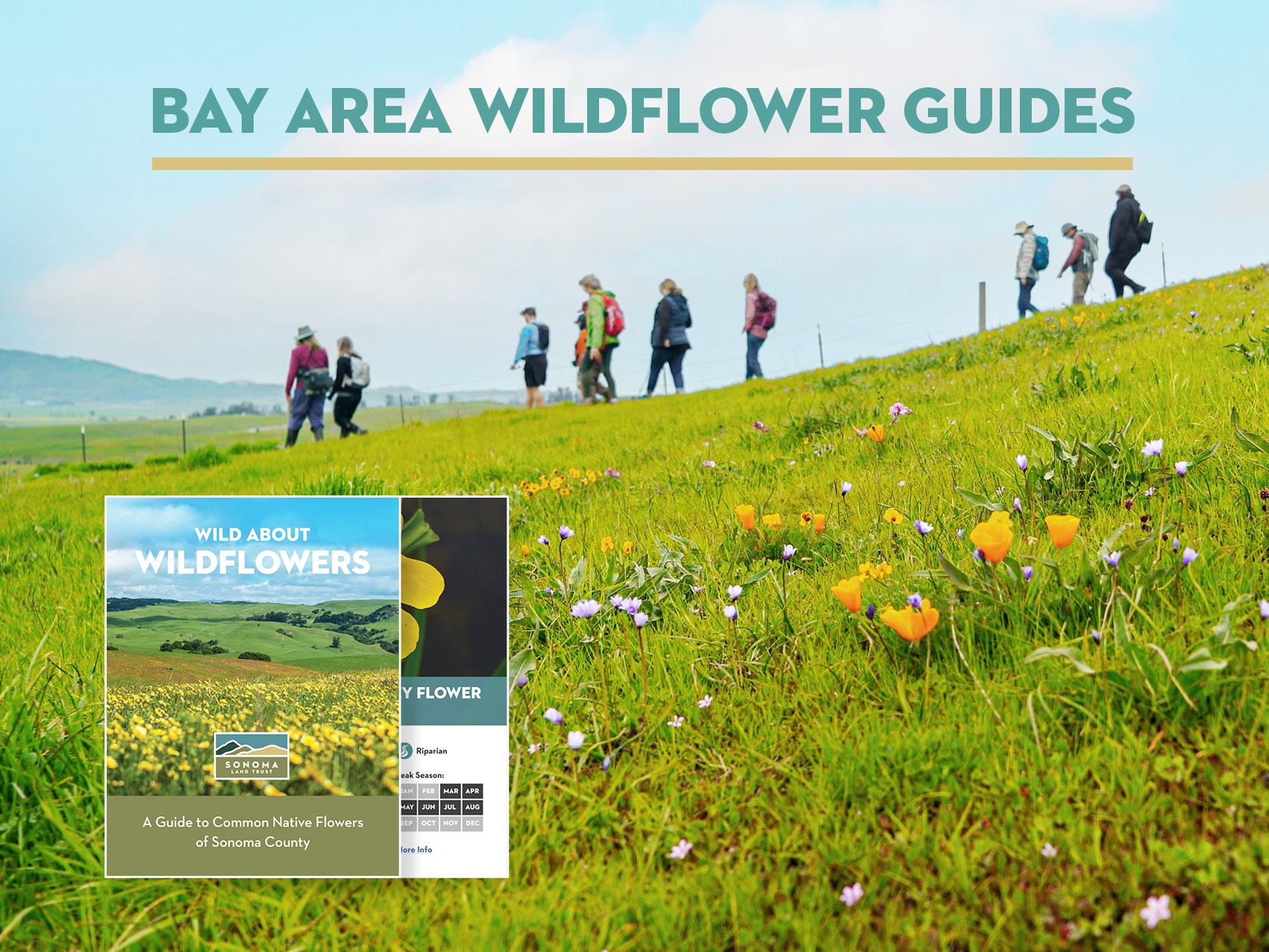
Want to learn more about wildflowers? Need a local guide to boost your wildflower ID skills? There are so many resources available. When outside and hiking, please remember that you are a part of nature and that your actions make a huge difference. Please stay on the main trails, pack out any trash, and respect these special and colorful places where wildflowers thrive.
Here’s that list of guides and articles from various organizations based in Sonoma County, the San Francisco Bay Area, and California. We hope they add a sense of adventure to your wanderings this spring.
Sonoma County Guides and Resources
- Wildflower Guide from Sonoma Land Trust;
- Wildflowers of Sonoma County by Sonoma County Regional Parks;
- LandPaths zine that includes wildflower ID and insight;
- Wildflowers on the Sonoma Coast – short article by The Wildlands Conservancy at Jenner Headlands;
- UC Master Gardener Program of Sonoma County – great resources on native plants (including wildflowers) to plant in gardens.
SF Bay Area Guides and Resources
- 21 Beautiful Native Wildflowers of Mount Diablo from Save Mount Diablo;
- Rare Botanical Gems – short article by Napa Land Trust;
- Jepson Prairie Wildflowers – longer article from Solano Land Trust;
- Wildflower Resources from Bay Nature.
Statewide Guides and Resources
- Calflora – A nonprofit database to learn about wild plants of California;
- California Plants to Color – Coloring pages made available by the US Forest Service;
- California Wildflowers Guide from California Native Plant Society;
- iNaturalist – If there is a particular wildflower you’d love to see, enter the name and see if there have been any observations near you.
Let us know what you find out there and enjoy your time outside!
A life rooted in nature: meet Legacy League member Sarah Reid
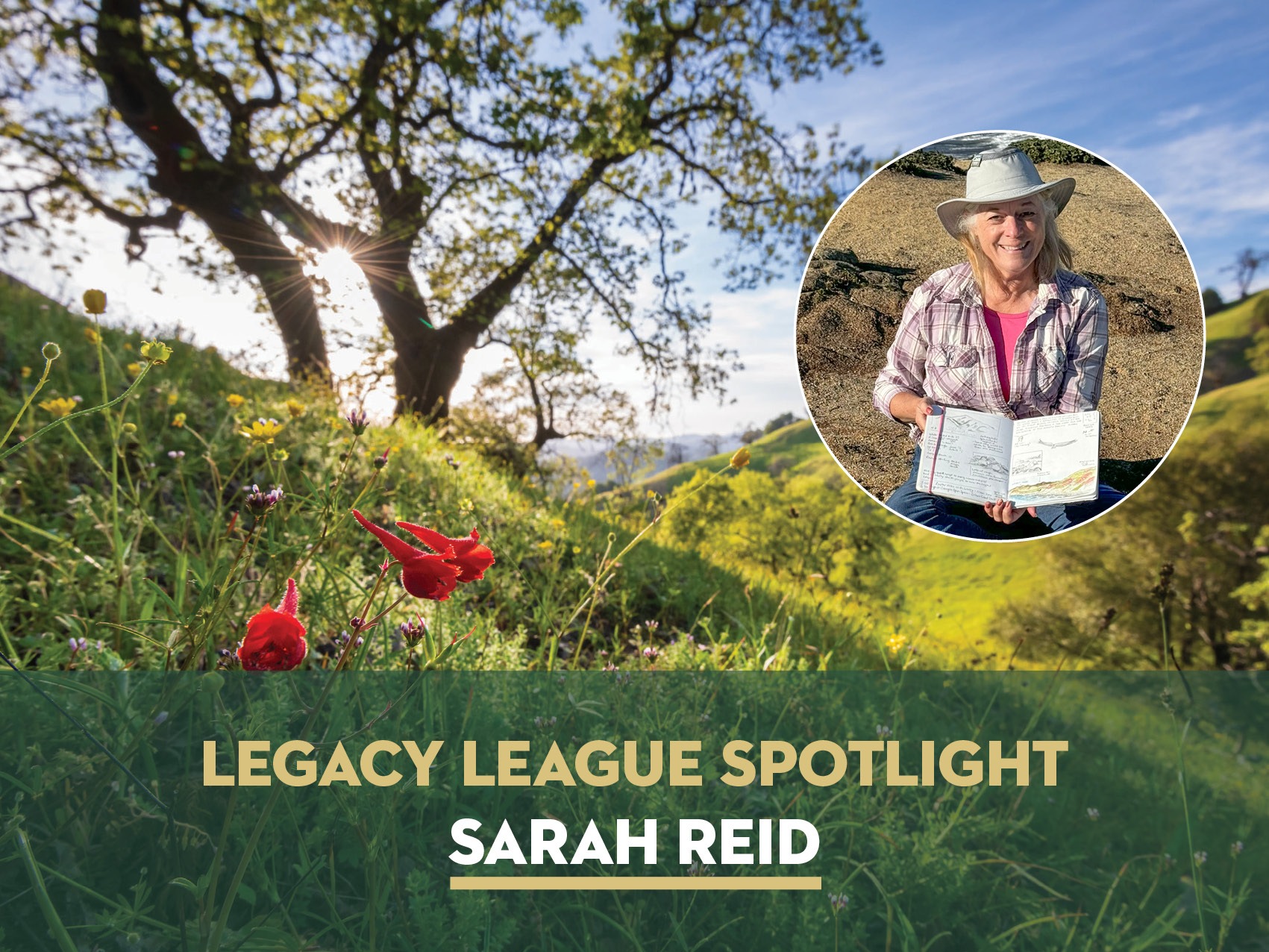
For Sarah Reid, nature has always been more than a place to visit—it’s a way of life. Growing up in Sonoma County, Sarah’s love for the land was sparked by childhood camping trips, where she spent summers exploring forests, rivers, and national parks with her family. These early experiences laid the foundation for a lifelong commitment to conservation and stewardship.
Sarah has spent decades volunteering in parks and preserves, amassing thousands of hours working with organizations such as Sonoma County Regional Parks, California State Parks, and the Sonoma Land Trust. From leading educational programs to conducting wildlife surveys and patrolling trails on horseback, her dedication to preserving and sharing Sonoma County’s natural beauty is unwavering. A generalist naturalist and avid contributor to iNaturalist (@wildmare64) with nearly 50,000 observations, Sarah finds joy in documenting the diverse flora and fauna that make this region so special.
Her passion for public access to nature is deeply rooted in her belief that people protect what they know and love. “When people develop a personal connection to a place, they become better stewards of it,” she says. While she strongly advocates for maintaining trails and access to open spaces, she also recognizes the importance of conserving some lands for habitat restoration and ecological balance.
Sarah and her husband’s love for Sonoma County extends beyond their lifetimes. As members of the Legacy League, they have chosen to leave a lasting impact by supporting the Sonoma Land Trust in their estate plans. “We don’t have children, so when we thought about where we wanted our legacy to go, it was an easy choice,” she explains. “Sonoma Land Trust’s mission aligns with everything we believe in—protecting land, restoring habitats, and ensuring future generations can experience the same wild places we cherish today.”
Through her tireless volunteerism and commitment to conservation, Sarah embodies the spirit of stewardship. Her story is a testament to the power of personal connection to the land and the enduring impact of giving back to the places that shape us.
Join the Legacy League

Join Sonoma Land Trust’s Legacy League and make a lasting impact—commit a future gift in your will or trust, and Dianne Brinson and Mark Radcliffe will donate $1,000 now, up to $30,000, to support critical conservation projects today.
News
Welcome Chloe!

Please join us in welcoming Chloe Howard to the Sonoma Land Trust team as the Community Engagement Programs Assistant! Chloe brings a passion for science and conservation to her role and shares her deep love of nature with the world.
Community events
Santa Rosa Earth Day Celebration
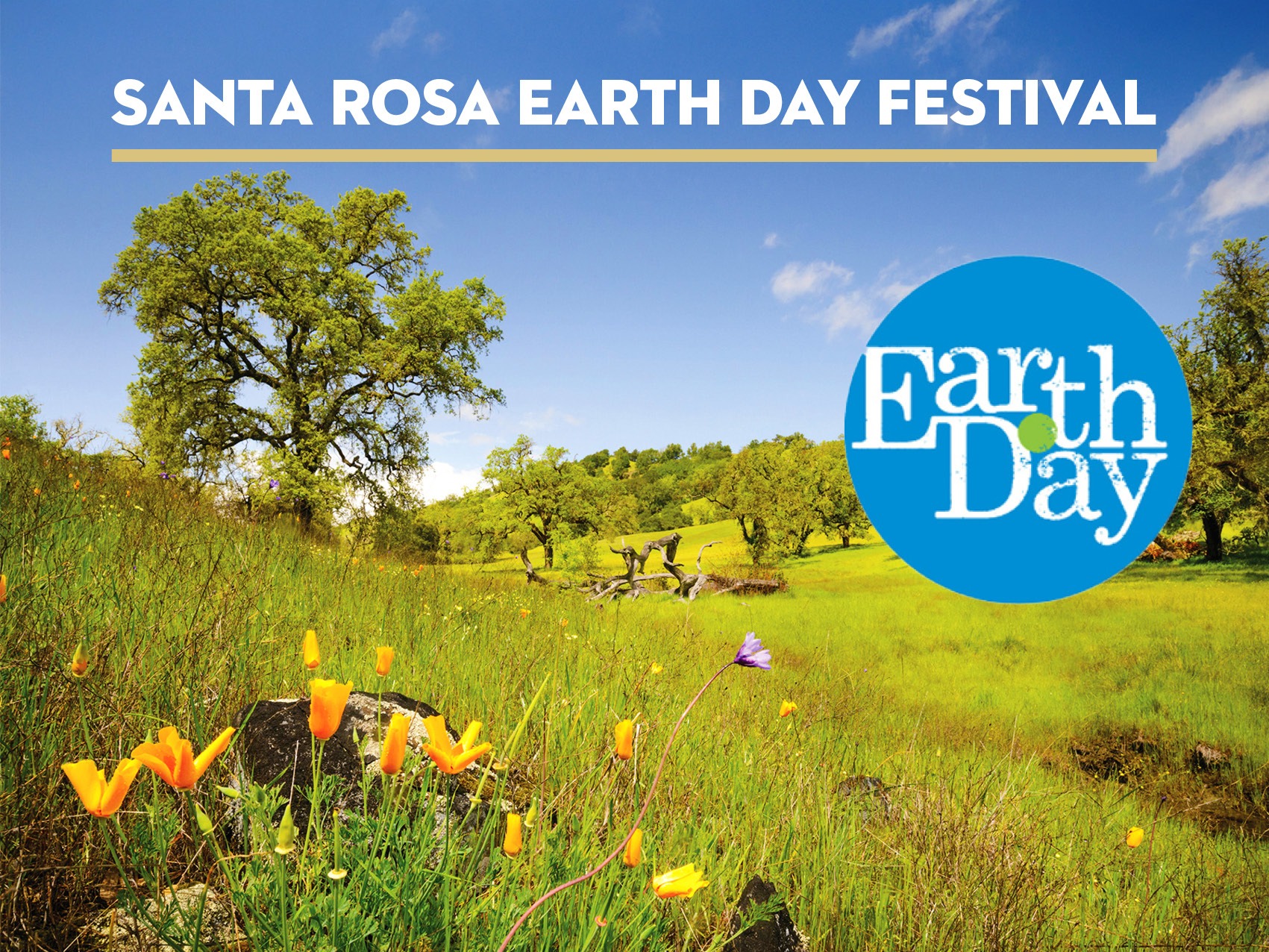
Date: Saturday April 26, 2025
Time: 12pm-4pm
Location: Santa Rosa Courthouse Square
Find our booth at the family-friendly, zero-waste Earth Day festival with live performing arts, great food, and inspiring exhibits that raise environmental awareness.
Cinco de Mayo
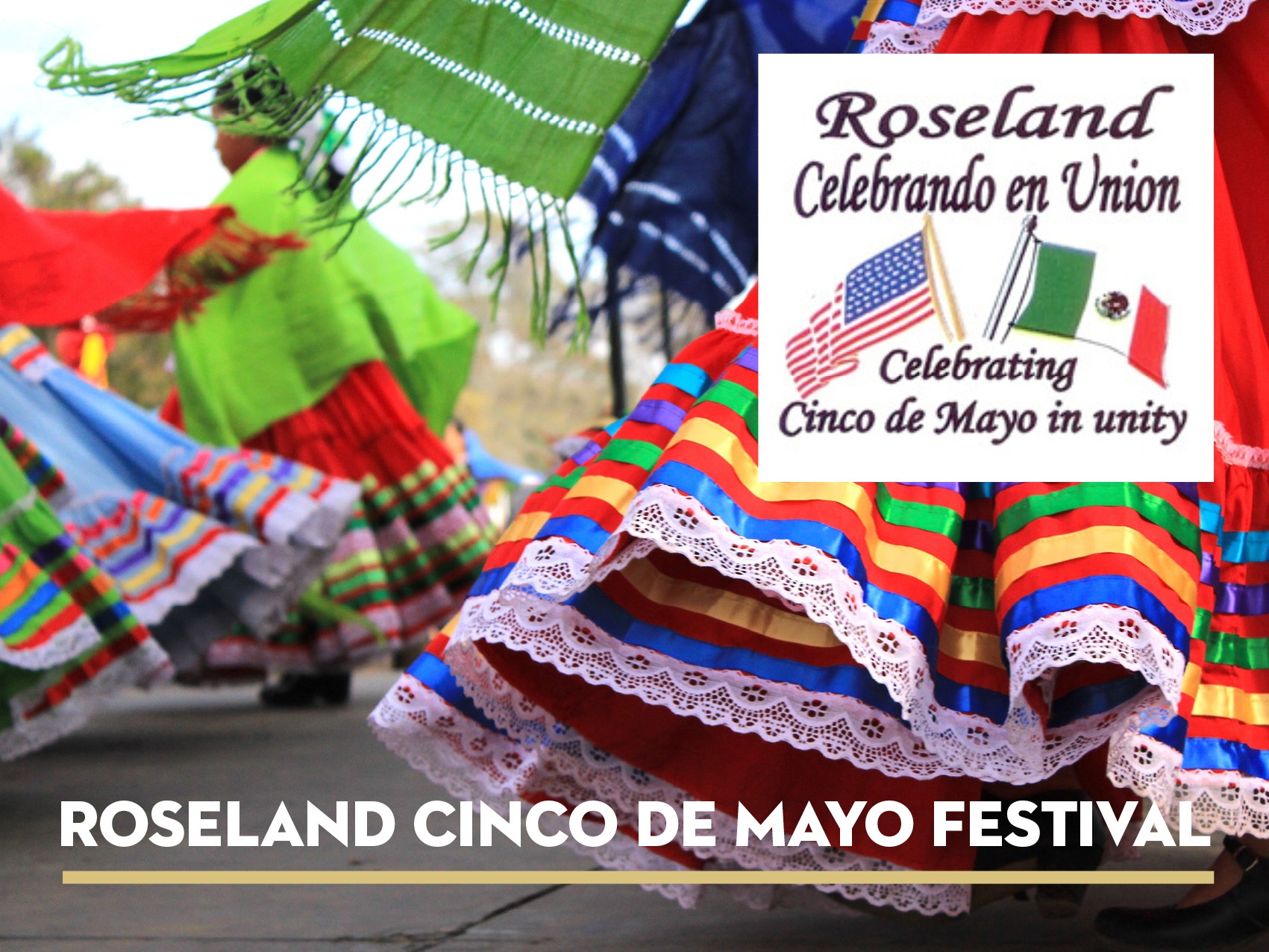
Date: Monday, May 5,
Time: 4pm-9pm
Location: Sebastopol Road
The festival features local entertainment, fun for the kids, informational booths, food trucks,, crowning the “Reina del Cinco de Mayo”, and an awesome low-rider car show.
Save the Date – Child in the Wild
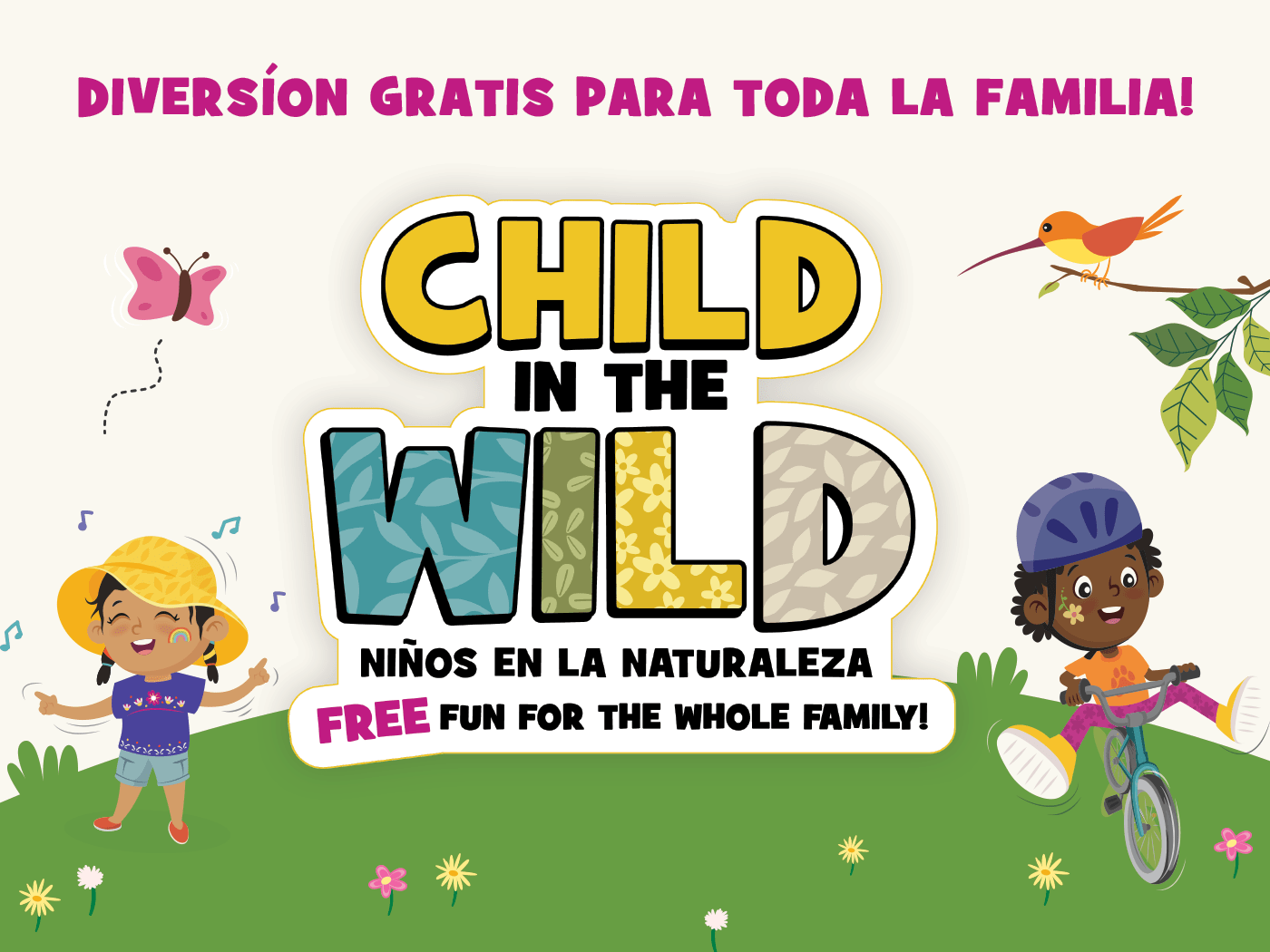
Date: Sunday June 1
Time: 12pm-4pm
Location: Howarth Park
Child in the Wild: Niños en la naturaleza We are hosting our fourth annual family-friendly event with live music, crafts, bounce houses, food trucks, vendors, and more! Learn about the Southeast Greenway and share your vision for the new park.
Free outings
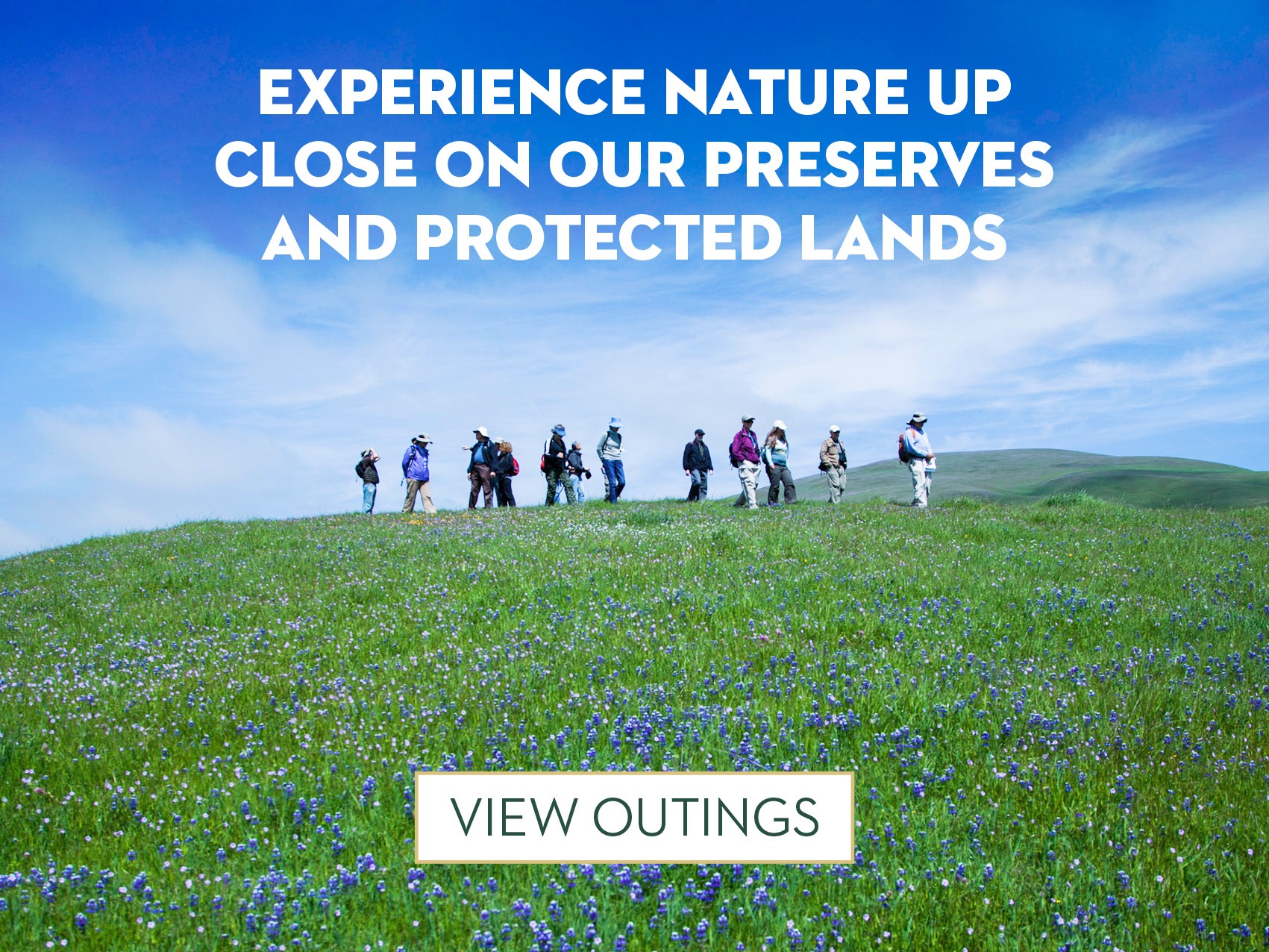
Join us out in nature this month! In addition to our monthly bilingual Familias al Aire Libre/Families Outdoors outing, we’re hosting a series of weekend hikes across the county, including wildflower walks.
Many of these hikes are in partnership with Sonoma County Ag + Open Space.
New Program!
Community in Nature: Wellness Wednesdays
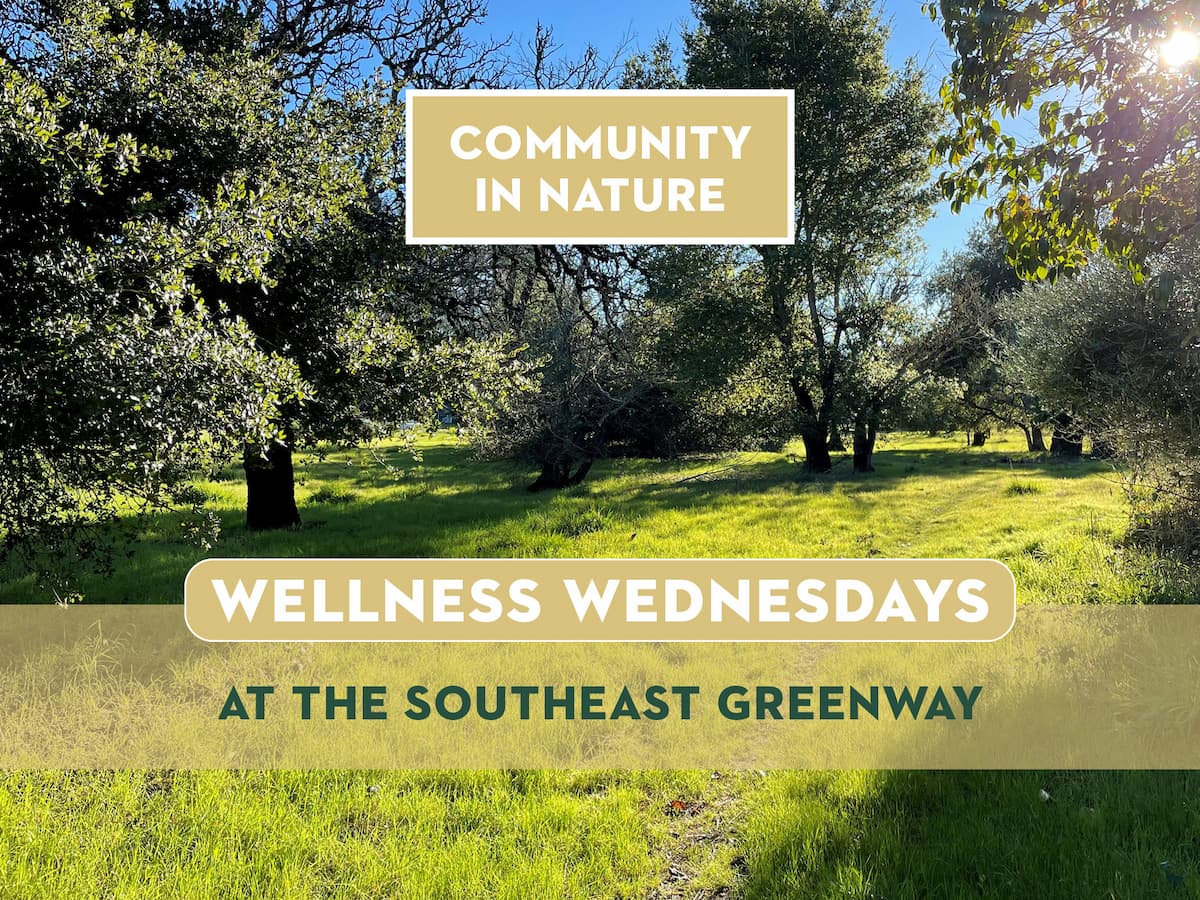
Dates: Wednesdays starting April 9
Time: 3pm-4pm
Location: At the future Santa Rosa Southeast Greenway park, by the Friedman Center
Pre-registration required: space is limited
Join us for Wellness Wednesdays featuring yoga, sound healing, and forest bathing.
Experience balance and connection with Sonoma Land Trust’s free Community in Nature program at the future Southeast Greenway.
Earth Day BioBlitz at the Southeast Greenway
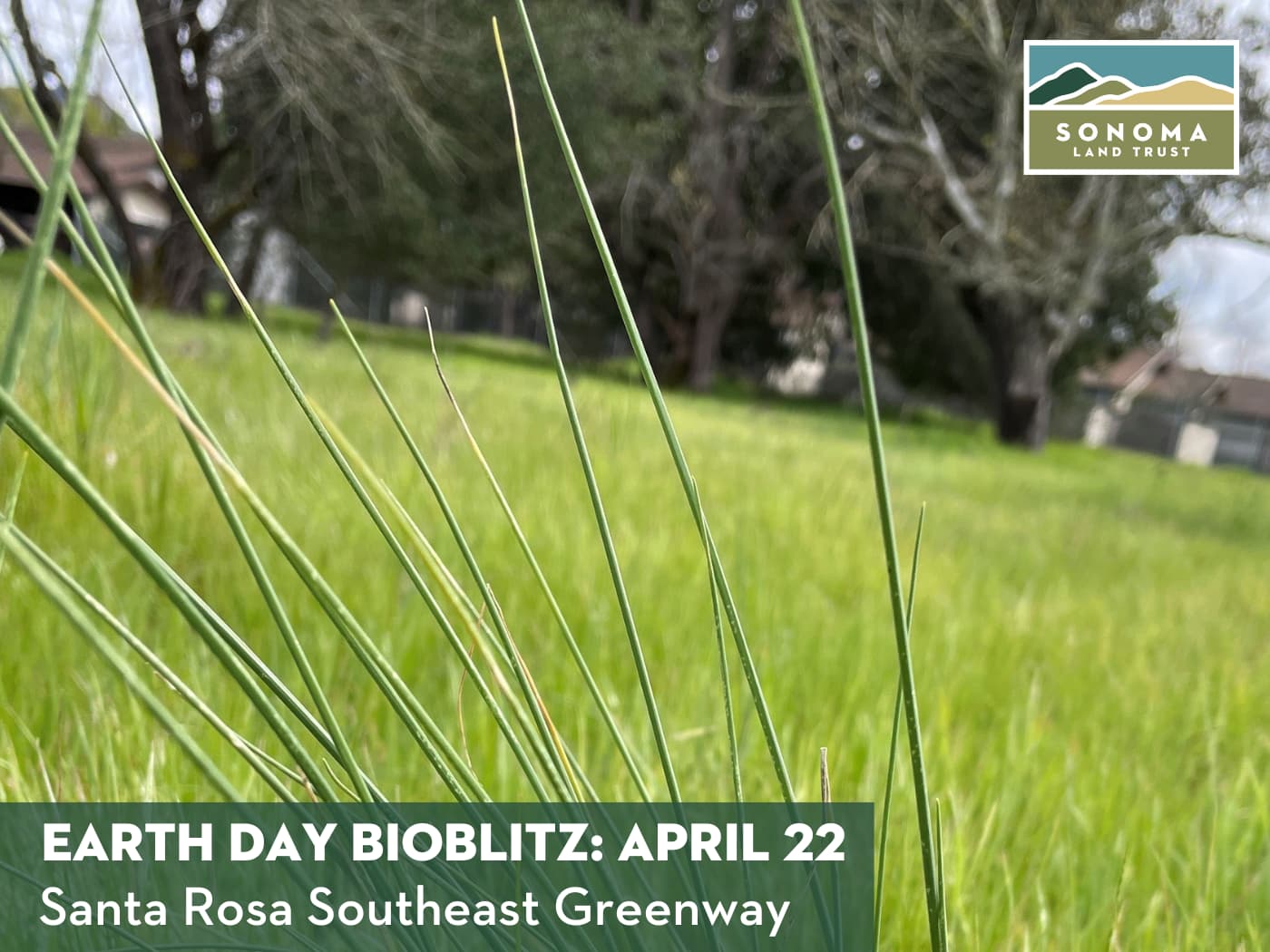
Date: April 22
Time: 4pm
Meet on Franquette Ave, east of Montgomery High School
Join Sonoma Land Trust and guest presenter Sarah Reid for an Earth Day Bioblitz on the Santa Rosa Southeast Greenway! We’ll start off the day with an orientation by Sarah Reid, who will teach us how to use the iNaturalist app and give us tips for getting the best photos for identification. Then feel free to wander the Southeast Greenway and take photos documenting all the nature you find!

